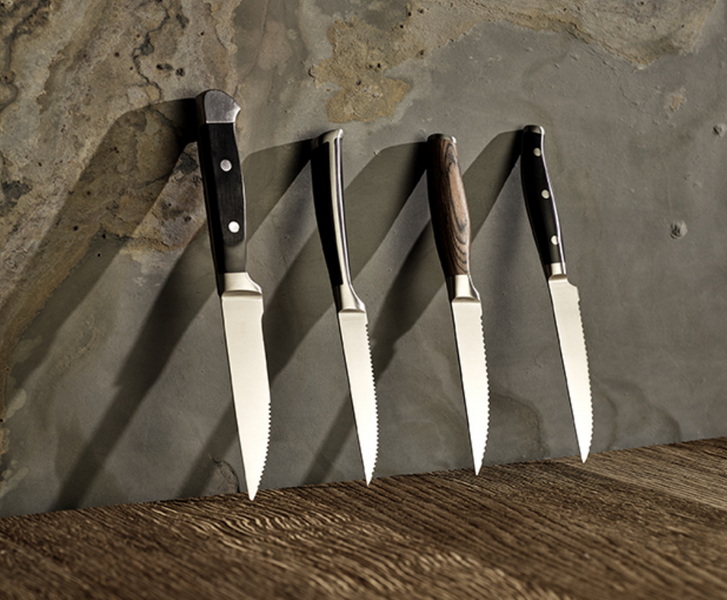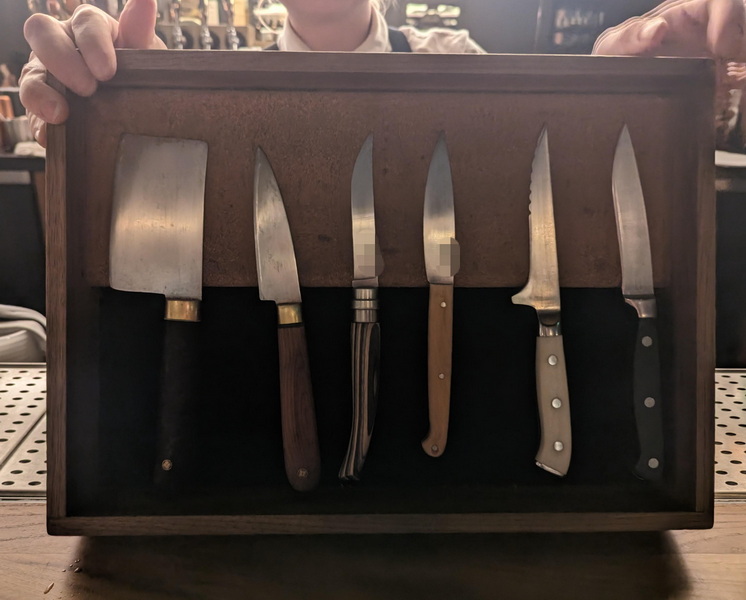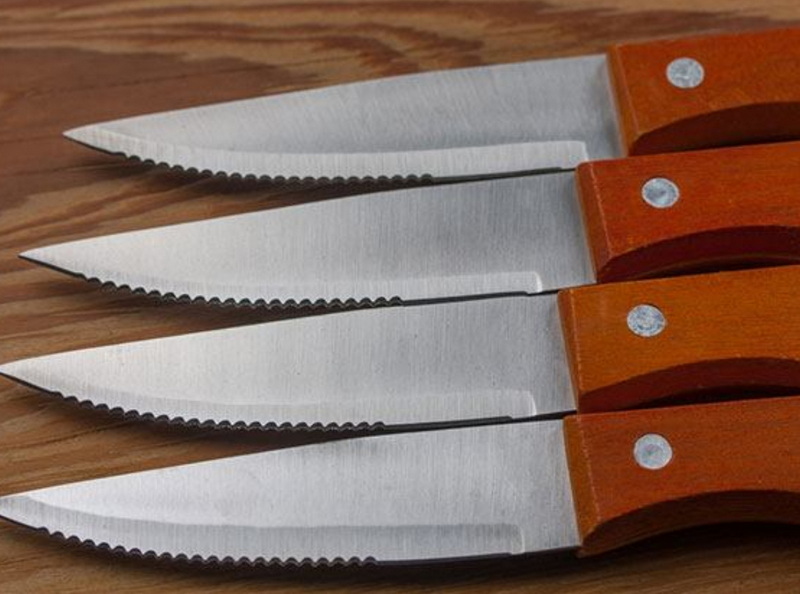- All
- Product Name
- Product Keyword
- Product Model
- Product Summary
- Product Description
- Multi Field Search
Views: 222 Author: Ann Publish Time: 2025-10-28 Origin: Site











Content Menu
● Edge geometry and sharpening
● Tactile and aesthetic considerations
● Performance in real-world settings
● Guidelines for selecting a Steak Knife for OEM projects
● How to select the right Steak Knife for your table setting
● Practical care and maintenance tips
● Practical OEM considerations for scale and branding
● Carefully curated material and process options for OEM partners
● The role of imagery and media in product positioning
● Testing and validation for OEM applications
● Addressing global market considerations
● Branding and customization examples for OEM clients
● Sustainability and ethical considerations
● FAQ
>> 1: What is the primary purpose of a steak knife?
>> 2: Which blade materials are best for restaurant-grade steak knives?
>> 3: Should steak knives be serrated or straight-edged?
>> 4: What handle materials are recommended for OEM steak knives?
>> 5: How important is branding on steak knives?
In any well-set table, the right Steak Knife can elevate the dining experience, signaling quality and attention to detail. For brands and OEM clients, selecting the perfect steak knife involves balancing blade material, edge geometry, handle design, and price point to meet diverse customer needs. This guide helps you understand the essential factors to consider when choosing a steak knife for premium table settings, hospitality venues, or consumer-grade products that carry your brand's mark.

A Steak Knife is a specialized dining knife designed to cut through cooked beef and other meats with precision and ease. Unlike generic kitchen knives, steak knives emphasize a fine balance between sharpness, durability, and ergonomic handling suitable for table use. The term encompasses various blade styles, including straight-edged, serrated, and combination-edge blades, each offering distinct cutting advantages.
- Stainless steel: Most common for table-grade Steak Knife due to corrosion resistance, ease of maintenance, and cost efficiency. Popular alloys include 410, 420, 440C, and higher-end 13- or 14-series stainless steels.
- High-carbon stainless steel: Blends hardness with corrosion resistance, providing a longer-lasting edge and sharper point retention.
- Carbon steel: Known for exceptional edge retention and sharpness, but requires more maintenance to prevent rust and patina, especially in humid environments.
- Damascus or layered steel: Offers distinctive aesthetics and potential performance benefits from layered hard cores, appealing to premium brands targeting food enthusiasts.
- Plain edge: A straightforward edge suitable for most steak cuts, offering predictable performance and ease of sharpening.
- Micro-bevel: A small secondary bevel improves durability and edge life, especially for home cooks who frequently re-sharpen.
- Hollow-ground or hollow-ground profiles: Create a thinner edge with reduced drag, aiding clean cuts through tender steaks but may be more challenging to sharpen.
- Serrated vs. straight-edged: Serrated blades excel at cutting through tougher crusts or compacted meat fibers, while straight-edged blades deliver cleaner slices and better control for delicate cuts.
- Rockwell hardness: A higher hardness (measured on the Rockwell scale) typically correlates with sharper edges and longer life, but harder steels can be more brittle if mishandled.
- Full tang construction: Ensures balance and durability, with the blade running through the entire length of the handle.
- Material options: Polymer composites, POM, pakkawood, micarta, or stainless steel handles—each offering different grip feel, heat resistance, and aesthetics.
- Ergonomics: A well-shaped handle supports natural finger placement, reduces fatigue, and improves precision during service in high-volume settings.
- Maintenance considerations: Some handle materials require oiling or conditioning, while others are virtually maintenance-free.
- Weight and balance: A well-balanced knife improves cutting efficiency and comfort at the table during long meals.
- Finish and polish: Mirror finishes are visually striking for formal settings, while satin or brushed finishes can hide minor scratches and wear.
- Visual branding: For OEM projects, laser engraving, etched logos, or branded handle inlays can differentiate your product line.
- Domestic kitchens vs. commercial settings: Home use prioritizes comfort and ease of maintenance, while professional environments demand robust edge retention, sanitation ease, and consistent performance after repeated washings.
- Food compatibility: Some profiles are better suited for certain meats (steaks, roasts, or cultured preparations), while others offer versatility across a meal.
- Target market and price range: Define whether the product will sit in entry-level, mid-range, or premium segments and align material choices, finish, and packaging accordingly.
- Material sourcing and consistency: Work with suppliers who can deliver consistent alloys, heat-treatment protocols, and quality control checks to ensure uniform performance across a product line.
- Packaging and presentation: For table settings, packaging should communicate quality and brand identity. Consider individual presentation boxes, sets, and gift-ready packaging with a premium look.
- Compliance and safety: Ensure materials meet food-contact safety standards and that handles are on the non-slip side, with smooth edges to avoid injuries during use.
- Supply chain and OEM capabilities: Coordinate tooling, dye methods, laser engraving, and packaging design with your OEM partner to achieve efficient scale-up and consistent branding.
- Step 1: Define your setting and typical menu. Consider the types of steaks (ribeye, filet, sirloin), thickness of slices, and preferred serving temperatures.
- Step 2: Determine consumer expectations. Are buyers seeking pure performance, luxury aesthetics, or a balance of both?
- Step 3: Choose materials that align with maintenance routines. High-humidity environments or frequent washing should steer you toward robust stainless alloys and low-maintenance handles.
- Step 4: Validate edge retention and sharpenability. Evaluate heat-treatment processes, sharpening ease, and whether your target users will rely on home or professional sharpening services.
- Step 5: Plan branding and packaging. Decide whether to incorporate logo engraving, packaging inserts, or gift-ready boxes to enhance perceived value.

- Cleaning: Rinse and dry promptly after use; avoid leaving knives soaking in water to prevent handle damage or corrosion.
- Sharpening: Establish a consistent sharpening schedule depending on usage. Use the appropriate angle and sharpening apparatus for your blade type.
- Storage: Use a knife block or magnetic holder with proper protection to prevent edge dulling and accidental injuries.
- Handling: Avoid dropping knives or banging them against hard surfaces, which can damage blades and handles.
- Brand identity: The Steak Knife line is a canvas for brand storytelling. Through handle aesthetics, laser engraving, and packaging, you can convey a narrative of craftsmanship, reliability, and culinary precision.
- Custom packaging design: Customized gift-ready packaging with insert cards detailing care guidelines and origin stories enhances perceived value and encourages wholesale partnerships.
- QA/QC pipelines: Establish rigorous QA/QC to verify blade hardness, edge angle consistency, and handle fit across every batch. This reduces returns and reinforces brand confidence.
- Regulatory alignment: Ensure compliance with food-contact safety standards, labeling requirements, and any region-specific serialization or warranty terms.
- For premium markets: Offer high-end options such as Damascus-pattern blades with stabilized wood or micarta handles and bespoke engraving. This strengthens storytelling for luxury table settings and chef-driven campaigns.
- For mid-range markets: Use reliable stainless steel alloys with well-proven heat-treatment protocols and durable Pakkawood or polymer handles to balance performance and cost.
- For entry-level markets: Focus on value-driven stainless steels, simpler packaging, and easy maintenance messaging to appeal to first-time buyers or hospitality buyers stocking multiple tables.
- Product photography: Consistent lighting and close-up shots of edge profiles, handle textures, and blade geometry help buyers assess quality quickly.
- Lifestyle visuals: Images depicting dining scenarios, restaurants, and home tables demonstrate real-world use and support marketing campaigns in different regions.
- Edge retention tests: Measure how long the initial sharpness lasts under simulated cutting tasks. Compare new blades against established benchmarks to demonstrate longevity.
- Corrosion resistance: Conduct salt spray tests and humidity exposure cycles, especially for coastal markets or restaurants with high-temperature dishwashing.
- Handle durability: Simulate repeated wash cycles and impact testing to ensure handle integrity and slip resistance.
- Ergonomic assessment: Gather feedback from professional chefs and service staff for comfort and fatigue reduction over extended use.
- North American markets: Emphasize reliability, family-friendly safety, and cleanable designs, with branding that communicates premium value and warranty support.
- European markets: Highlight craftsmanship, blade aesthetics, and sustainable materials, aligning with regional preferences for design-forward cutlery.
- Asia-Pacific markets: Focus on value balance, food safety norms, and accessibility, with options for region-specific branding and bilingual packaging.
- Australia and other regions: Leverage partnerships with distributors who value rugged materials and long-term service support.
- Logo placement: Laser-engraved blades or engraved logos on the handle scale can be tailored to specific brand guidelines without compromising balance.
- Menu-ready packaging: Include care instructions, warranty details, and brief brand stories in multiple languages to facilitate cross-border sales.
- Signature finishes: Offer brushed, mirror-polished, or satin blade finishes to match restaurant or retail branding aesthetics.
- Material sourcing: Prioritize suppliers with responsible mining and ethical wood harvest practices for handle materials.
- Packaging: Use recyclable paper-based packaging and minimize plastic usage where possible.
- Longevity messaging: Position the Steak Knife as a durable, repairable tool to reduce waste and support sustainable dining experiences.
Selecting the right Steak Knife for a table setting is a multifaceted decision that blends material science, ergonomic design, brand storytelling, and market strategy. For OEM collaborations, aligning blade steel, edge geometry, handle comfort, packaging, and after-sales support with target markets ensures a product that excels in performance and presentation. A thoughtful choice in steak knives strengthens brand perception, elevates dining experiences, and supports enduring partnerships with international retailers, wholesalers, and manufacturers.
Here are five concise items with appropriate H-tag structure to fit your article.

A steak knife is designed to make clean, precise cuts through cooked meats at the table, combining sharpness, durability, and ergonomic handling for an enhanced dining experience.
High-carbon stainless steel offers a balance of edge retention and corrosion resistance, while premium options may use Damascus or layered steels for aesthetics and performance.
Serrated blades excel at cutting through crusts or dense fibers, while straight-edged blades provide cleaner slices and finer control for delicate cuts.
Pakkawood, micarta, or durable polymer handles are common for a comfortable grip, good heat resistance, and reliable durability in both home and commercial settings.
Branding is crucial for OEM partners. Laser engraving or logo inlays on blades or handles can differentiate products and reinforce brand identity, especially in hospitality and retail channels.
The Ultimate Professional Knives for Halal Butchery in Middle Eastern Kitchens
Chef Knife Size Guide: Choosing Between 6″, 8″, 10″, And 12″
Custom Knife Handles: How To Design A Chef Knife That Fits Your Hand Perfectly
Chef Knife Surface Treatments Guide: From Polished Migaki To Damascus Patterns
Inside Our Professional Knife Sample Room: Quality You Can See
Universal Knife Block Buying Guide: Modern Acrylic & ABS Knife Holders for Professional Kitchens
Universal Knife Block: The Complete Guide To Modern, Hygienic Knife Storage
The Complete Guide To Red Handle Knife Sets: Style Meets Functionality in The Kitchen
Professional Knives for Halal Butchery And Middle Eastern Cuisine